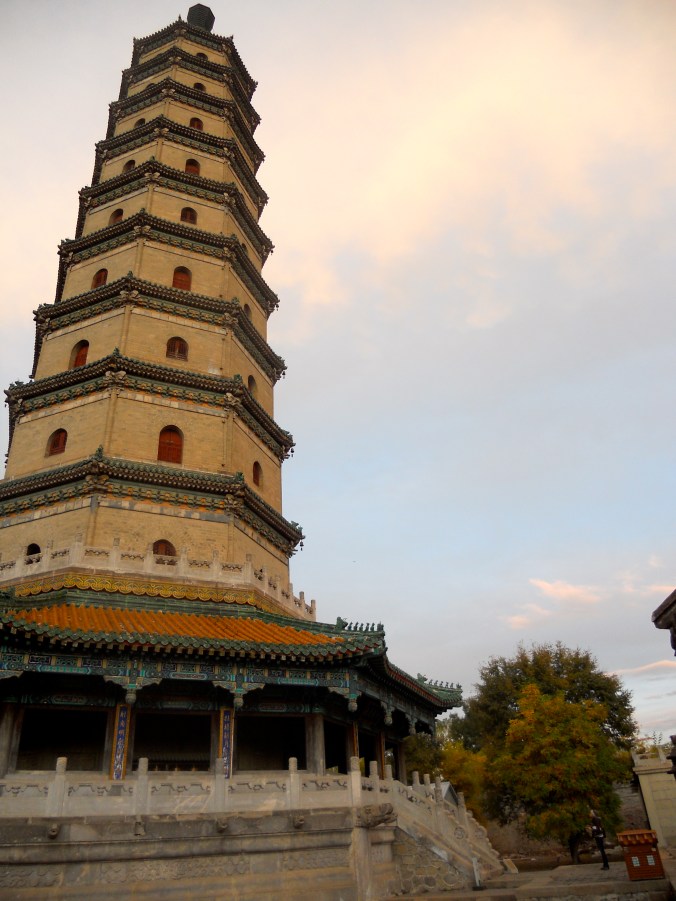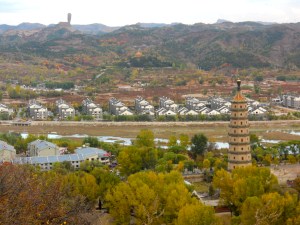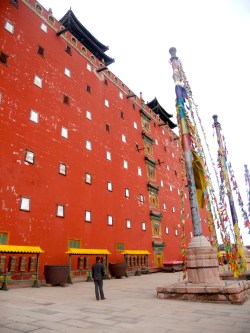I went to Chengde on a whim, and it turned out to be the best city I had never heard of. My mother and brother were visiting Beijing from Kentucky, and I wanted to take them somewhere outside the Chinese capital so they could experience a different part of the country.
I picked Chengde because it was close and had a lot of history. During the Qing (1644-1911), China’s last dynasty, it served as a getaway for the royal family. Situated 250 kilometers northeast of Beijing, Chengde with its rolling mountains and thick forests provided a cool and scenic escape from the capital’s blistering hot summers and flat landscape.
We went in the fall, when the leaves had turned brilliant shades of red, yellow and orange. Chengde’s main historical site is Bishu Shanzhuang, an imperial summer resort that began construction in 1703. Admission was pricey – 120 RMB ($19) – twice what it costs to tour the Forbidden City in Beijing. But the resort’s impressive mountain lookouts justified the expense.
After a stomach-turning bus ride up a narrow, winding road (brakes apparently optional, oncoming traffic be damned), we reached a perimeter wall where the Manchurian emperors and their families used to ride their horses, overlooking the Putuo Zongcheng Temple. The temple, built in 1771 and Chengde’s largest, was modeled after the Potala Palace in Tibet.

The bus tour of the imperial summer resort stopped at several other lookouts, each with a view as beautiful as the one before. The tour took about an hour, but if you choose to walk I imagine it would take an entire day. At 5.6 million square meters, the resort houses the largest imperial garden in China.
As we toured the rest of Chengde, my brother and I kept noticing a giant rock formation on the horizon. We both agreed that we needed to see it up close. A ski lift took us to the base, and after a short walk up some steps we were on the rock. The formation is called Sledgehammer Peak, which locals refer to as “the thumb of God” because from a distance it does resemble a clenched fist with the thumb sticking up.
If I have nothing to hold on to, heights scare me. A yellow line had been drawn less than a meter from the edge on either side of the rock’s base. The only thing preventing you from falling was a chain rope. The rope was hung about knee high, not nearly high enough to catch an adult from plunging to death. I don’t know what purpose it served.
As I approached the edge, the wind whipped around me, and my knees became weak. A couple of girls no older than 12 dashed past me and sat much closer to the edge, chatting, smiling and posing for pictures.
I climbed down questioning my manhood, but left without any doubt that Chengde is one of China’s hidden beauties.









Great title and shots!
Such beautiful,colorful pics! We meant to include Chengdu and Leshan in our itinerary, but ran out of time:-( You might be interested in some of the off the beaten spots around Chongqing that I have posted about in my blog. Look forward to more interesting China stories from you!
If you ever come back, it’s definitely worth checking out. Time magazine wrote an article about Chengde a few months. It has a lot of good information about the city. Here’s a link.
http://www.time.com/time/travel/article/0,31542,2079489,00.html
JImmy
love the photos. Does it really look like that? Looks so clean
Thanks! Yes, it really does look like that. I think the local people do a good job of keeping the city looking nice. Even the downtown area was pretty clean, compared to other Chinese cities I’ve been to.
Amazing! What an interesting place and your photos are beautiful!
I’m glad you enjoyed them!
Looks like an interesting place, and the hike up those steps looks like it would be quite strenuous.
I’m enjoying reading about your China experiences. Fascinating country. Visited Beijing, Nanchang and Guangzhou 10 years ago. Would have loved to have seen more of the country, but the air quality caused a severe upper respiratory infection, so I doubt that I’ll go back. So I’ll travel along with you vicariously if you don’t mind.
Thanks for dropping by, and thanks for the compliment. I didn’t have respiratory problems before I moved to Beijing, but now I’m frequently congested and get sore throats every so often that last a day or two. I’ve just accepted it as a tradeoff for living here. Nearly every large city I’ve been to in China has problems with air pollution. Hopefully, they’ll eventually make a push for cleaner air.
My infection was so severe that I lost about 90% of my hearing on my right ear (didn’t realize at the time, that that would happen), but I was really sick.
That said, China is a fascinating place and I’d go back in a heartbeat if I were younger. How long do you plan to stay? Have you been to any other provinces? How much Mandarin do you speak? I’m really curious about how an American can make the adjustment required to live in China. I have a lot of questions, and if you’d prefer to not answer them on the blog, I think you have my email address. I’m originally from Europe, but have lived in the US since 1965.
Geez, that’s horrible. I definitely don’t recommend living in Beijing to anyone who has respiratory problems.
Right now, I plan on staying at least through the summer. The job market for journalism jobs is still better in China than the US. So for now, I want to stay where the work is. I’ve been to Qingdao in Shandong province on the coast, Xi’an in Shaanxi province and Chengde in Hebei province. I’d like to do more traveling in China, but I’ve used a lot of my holiday time to travel home to visit family.
I’ve been studying Chinese for about five months with a private tutor. I’m learning how to recognize characters, but I don’t know many. Around 100, at most. I can speak enough to do simple things: order food, tell a cab driver where I’m going, wire money home, etc. Anything beyond a simple conversation is still very difficult.
As an American, I’ve found adjusting to living here fairly easy. I like the food in general, and I’ve made an effort to learn the language. I find the culture interesting too, and am reading some books on Chinese history. Now, if you don’t like the food, don’t want to try to learn any Chinese and aren’t interested in their history, then I don’t think the adjustment would go as well.
Feel free to email me at nesbitt.jimmy@gmail.com if you have more questions.
Fascinating pictures! Reminds me that compared to the US Europe may be the old country, but compared to China we are all still in diapers
Thanks for sharing
🙂 K.
Thanks. I’m glad you enjoyed the pictures. I agree with your comment. I’m from the US, and we call 100-year-old buildings “historic.” It’s all about perspective!
Wonderful post, what an amazing rock formation
Thanks for reading. It was one of the cooler rock formations I’ve seen.
Your pictures are beautiful! You have officially talked me into visiting Chengde next time I’m in China 🙂
Cheers
Great! It’s worth visiting if you’re in Beijing for more than a week. And if you’re traveling on a budget, it’s very affordable too.
Wow, had no idea any of this existed! Ancient rich people camp getaway! Must have been nice, haha.
It was a nice escape from the hustle and bustle of Beijing!